
|
AN INDIAN SILVER REPOUSSÉ RAMAYANA BOWL
Poona, Maharashtra, India, c.1900
Of compressed circular shape, resting on a tall circular foot, both the body and the foot worked with bold repoussé decoration, the central band on the body illustrating scenes from the Hindu epic Ramayana, Rama and Lakshmana identifiable by their bows, Ravana by his several heads and arms, and Hanuman and Sugriva's monkey army by their faces and body features, on a ring-punched oxidised background to enhance the dramatic effect, above and below the main figural composition decorative bands of lush palmette leaves and half-rosette medallions on the rim, the foot ornate with courtly and village scenes, 26.5cm diam.
The attribution to the silverware production of Poona is mostly due to the subject depicted and the decorative technique used. Indeed, two main types of wares were produced in Poona: one was very similar to Madras and Swami silver with scenes in high relief taken from the Hindu myths; the latter was almost reminiscent of certain Burmese and Lucknow productions, with distinctive bold repoussé reliefs very often taken from the Ramayana, regularly placed under cusped arches or in panels and against an oxidised background, similar to our example (Wynyard R. T. Wilkinson, Indian Silver 1858 - 1947, London, 1999, p. 169).
£1,000-£1,500
|
|

|
A JADE FLY-WHISK HANDLE
Mughal North India, 18th - 19th century
Of typical shape, with a thin, long central stick in green, the middle with a silver band, the two ends in white, possibly part of a different handle once, decorated in the shape of a blossoming lotus at the top and a lush rose at the bottom, finely carved, residues of dark substance in the carvings of the rose, 21cm long.
£800-£1,000
|
|

|
A SILVER HUQQA BASE
Possibly Calcutta (Kolkata) or Madras, India, 19th century
Of typical bell shape, with plain circular base, the decoration chased in high relief and consisting of a continuous band of vine tendrils and grape near the base and lush palmette leaves below the neck, stamped twice on the base 'CDS', 18cm high.
£600-£800
|
|

|
A SILVER HUQQA BASE
Hyderabad, India, 18th century
Of conical shape, on a large circular plain base, with flared neck and wide circular mouth, the engraved and chased decoration consisting of continuous bands of rosettes around the rim and neck, palmettes below the neck, and stylised scrolling lotus flowers around the base, 21cm high.
£300-£500
|
|

|
TWO INDIAN SILVER REPOUSSÉ SUGAR BOWLS
Bhuj, Kutch, North Western India, ca. 1900
Comprising an European-shaped lidded sugar bowl, with hemispherical body on a splayed short foot, decorated with scrolling vegetal tendrils, the lid handle bird-shaped, 11cm high; and an English-shaped sugar bowl with S-shaped handles, on a splayed foot, similar vegetal decoration, the cartouche engraved with the crest of a dove closed, holding in the mouth an olive branch fructed, with motto below HOPE, all above K. W. 1869-94, 9cm diam, and 8cm high.
The crest is probably for the Harkness family, the motto: Hope in God.
For similar teaset pieces with European crests, please refer to Wynyard R. T. Wilkinson, Indian Silver 1858 - 1947, London, 1999, p. 96, tab. 161.
£300-£500
|
|

|
AN INDIAN TOMBSTONE
India, 19th century
Of rectangular format, possibly made of quartz or light granite, with a polylobed upper end, the sides densely carved with epigraphic inscriptions with the name of the young deceased Nur Asad Khan bin Khan Beik Omar Khan (Azkheil?), funerary poetry and auspicious wishes, one of the sides with a decorative composition of an iwan filled with floral bloom and birds, more calligraphy around, the top end with floral and vegetal tendrils, approximately 109cm x 47.5cm.
Provenance: Spink & Son, London, 1980s.
£800-£1,000
|
|

|
A DECCANI GOLD-PRINTED HANGING
Central India, 18th - 19th century
The fine cotton profusely gold-printed in Rughni technique with a central floral motif supported by a pair of adosses sejants tigers, a pair of regardants crowned pseudo-sphinxes above, and a pair of active passants regardant tigers below, against a floral trellis ground, the top and bottom registers with a row of cypresses against a floral ground, the lower border with stylised circular elements inscribed with an invocation to Allah, Mohammad, and 'Ali, the figural motifs outlined in black, backed by unbleached cotton, 188cm x 96cm.
This charming piece, a rare survival of its type, is remarkable for its portrayal of female mythical creatures in an Islamic liturgical setting.
£600-£800
|
|

|
AN ENGRAVED BRASS PENBOX (QALAMDAN)
Possibly Deccan, Central India, late 19th century
With rounded ends and sliding tray, the top and sides engraved in a horizontal format with naskh calligraphic bands against vegetal sprays, stylised floral sprays on the sides, plain underside and internal tray, 23.5cm long.
£150-£200
|
|

|
λ AN INDIAN IVORY AND BONE-INLAID HARDWOOD SITAR
North India, late 19th - early 20th century
Of typical shape, with 3 main strings and 8 lower strings, with gourd-shaped resonance chamber and long hollow neck, the resonance chamber finely carved with vegetal and floral patterns, the body inlaid with engraved and red and black-painted ivory plaques with floral tendrils, leaves, doves and geometric motifs, the overall decorative design very close to Ravi Shankar style sitars, approximately 126cm high.
£200-£300
|
|

|
A LARGE PIERCED SILVER PEN CASE
Possibly Maharashtra or Northern India, 19th century
Of rectangular form modelled in the shape of a casket, resting on four feet resembling lion paws, the body decorated with interlocking vegetal tendrils and leaves and the lid with a grid filled with flower heads, the central lock inspired by Western caskets and accompanied by two lateral hooks with rosette roundels, 26.5cm x 8.6cm.
£400-£600
|
|

|
A SAFAVID-STYLE CARVED INDIAN YOUNG COCONUT
North India, 19th century
Of ovoid shape, carved in the round with exquisitely intricate floral and vegetal decorative bands, some panels filled with rectangular arabesque medallions, mounted on a Chinese-inspired curved pedestal, 10.2cm high.
£200-£300
|
|

|
A BIDRI SILVER-INLAID SPEARHEAD
India, late 18th - 19th century
Of typical shape, with a faceted spiky finial, the tapering cylindrical base inlaid in silver with floral sprays and geometric motifs, 28cm high.
£600-£800
|
|

|
TWO STEEL 'SCORPION' DAGGERS (BICHUWA / BICHWA)
Deccan or South India, 18th century
Comprising a dagger with sharp double-edged curved steel blade with thick medial ridge and lateral grooves, the hilt characteristically shaped as a metal loop acting as knuckleguard, decorated with silver-inlaid tendrils and ridged borders, dome-shaped finial to pommel, the sheath retaining some of the original madder velvet cover, 26cm long including the sheath; and a similar dagger with double-edged curved wootz steel blade, the hilt and ricasso ornate with red enamel and circular brass nails, dome-shaped finial to pommel, 23cm long.
£600-£800
|
|

|
A PAIR OF BRASS SPEAR HEADS
South India or Sri Lanka, 19th century
Of typical shape, with sharp drop-shaped finial, held up by two embracing hamsa (Brahmi ducks), their eyes inlaid with copper, the cylindrical base engraved with geometric motifs, 34.5cm long.
£600-£800
|
|

|
A SIKH TURBAN HELMET
Lahore, Punjab, mid to late 19th century
Of elliptical shape with a secondary smaller dome-like element surmounting the lower bowl, the iron body finely engraved and gilt, the decoration consisting of a central arabesque medallion at the top, interlocking vegetal tendrils in the round, and a band of cross-hatched squares near the edge, pierced to accommodate the mail now gone, 23.2cm x 20.3cm.
Provenance: Bought in the UK art market and in UK private collection since early 1980s.
The shape of this helmet, the missing nose-guard and porte-aigrette are certainly unusual elements which link it to the rare Lahore production of Sikh turban helmets. Very few have survived and are now mostly in museums and private collections. It is theorised that while the larger bowl is made to accommodate the wearers head, the smaller dome-like bowl is designed to accommodate the wearer's hair worn in a top-knot bun. This seamless secondary dome is completely enclosed from all sides with elegant rounded edges and smooth lines where it meets the primary bowl. For a similar example with more intense gold-damascened decoration and its full mail, please see the Asian Art Museum of San Francisco, inventory no. 1998.69.
£1,600-£1,800
|
|

|
A GOLD-INLAID PIERCED AXE (TABARZIN)
Possibly Mysore, India, 19th century
With a long, later added wooden shaft with brass rosettes, the crescent moon-shaped axe head pierced and decorated with two renversant lions, below them a lion attacking a gazelle, an engraved elephant near the joint of the blade to the base, epigraphic inscriptions on the base, 65.2 cm long including the shaft.
£600-£800
|
|

|
A SILVER-INLAID STEEL SHIELD
North India, 19th century
Of circular form and rounded profile with four central bosses, the background decorated with silver-inlaid intricate tendrils and leafy scrolls, the interior with full cover and madder red hand padding and holding straps, 30.5cm diam.
£400-£600
|
|

|
A SOUTH INDIAN DAGGER (KHANJAR)
Thanjavur (Tanjore), Tamil Nadu, South India, 19th century
With a plain sharp double-edged curved steel blade, the copper hilt with central ridged decoration and brass yali-shaped finial, the sheath with remains of madder velvet and gilt copper plaques at the top and bottom ornate with flowers and birds, 33.5cm long including the sheath.
£300-£500
|
|

|
A LARGE HOODED DAGGER (KATAR)
Southern India, 17th century
With a double-edged steel blade, the forte with a mythical creature, recessed central ridge, the copper-tinned handle with high volute-shaped hand-guard, engraved on the top and sides with vegetal and abstract motifs, 54.8cm long.
£600-£800
|
|

|
AN ILLUSTRATION TO A RAGAMALA SERIES: SHRI RAGA
Datia, Madhya Pradesh, ca. 1725-30
Opaque pigments heightened with gold and black ink on paper, a terrace scene depicting a lady drawing a portrait of her companion sitting on her knees in front of her and clapping her hands, the attendant behind them holding a fly-whisk, several parrots joining the scene on the tall trees on the right, the palace on the left of the composition ornate with a canopy on the interior and intricate carvings and dome-shaped chajjas on the exterior, the top with 6ll. of black and red ink Devanagari script against ochre yellow ground, set in bright red borders, 32.8cm x 26.2cm.
£1,200-£1,400
|
|

|
A PRINCE WITH A VISITOR
Possibly Sirohi, Rajasthan, North Western India, circa 1800
Opaque pigments on paper, the vertical composition depicting a prince with a pointed headdress, seated on a rectangular couch, holding a white rose, behind him a standing attendant with a fly-whisk, the visitor holding his hands tight in sign of greeting, the palace colourfully portrayed, mounted on white cardboard, 27.6cm x 19.5cm including mount.
£500-£700
|
|

|
A RURAL LADY ACROBAT
Possibly Kota, Rajasthan, North Western India, first half 19th century
Opaque pigments heightened with silver on paper, the vertical composition depicting a rural acrobat balancing on a pole, below her a drummer on the right and a male acrobat on the left, on light blue ground; framed within ochre yellow and red borders, glued onto a separate paper with black ink Devanagari notes, mounted on white cardboard, 27cm x 19cm including mount.
£300-£500
|
|

|
A ROYAL COUPLE ON THE TERRACE
Possibly Deogarh, Northern India, 19th century
Opaque pigments heightened with gold on paper, the vertical composition with an embracing royal couple on a madder red brocaded panel by the terrace, sumptuously dressed, the ruler with a green and golden halo, behind them a typical white pavilion with multi-coloured stained windows; cropped and pasted onto plain paper with purple borders, mounted on cream white cardboard, 30.3cm x 23 cm including mount.
£500-£700
|
|

|
WRESTLERS AND ACROBATS EXERCISING
Possibly Amber, Rajasthan, North Western India, 18th - 19th century
Opaque pigments on paper, the vertical composition depicting athletes working out and practising different disciplines from wrestling to arch shooting, from gymnastics to mallakhamba (pole gymnastics), a drummer on the left hand-side of the composition keeping the tempo, piles of athletes' colourful vests on the floor, the background with shrubs, cypress trees and floral bushes; the upper edge with 4ll. of black ink Devanagari script on ochre ground now washed-off, mounted on cream white cardboard, 46.4cm x 36.5cm including mount.
£600-£800
|
|

|
RAMA AND LAKSHMANA FIGHTING AGAINST THE DEMON KING RAVANA
Malwa, India, late 17th century
Opaque pigments heightened with gold on paper, the vertical composition depicting the final battle of the Ramayana epic, Lakshmana and Rama on the shoulders of King Sugriva's warrior monkeys confronting with their bows and arrows Ravana, the multi-headed and multi-armed demon king of Lanka - guilty of kidnapping Sita, Rama's consort; Ravana's demons hit by arrows and bleeding in the foreground, a multitude of arms on the ground highlighting the tension and pathos of the scene; the upper edge with a red floral border on yellow ground, the verso with a black ink Devanagari inscription, mounted on white cardboard, 37cm x 26.8cm including mount.
£800-£1,000
|
|

|
EXPECTANT KRISHNA
Amber School, Rajasthan, North India, second half 18th century
Opaque watercolour on paper, seated Krishna expecting his companion who is at the floor below, preparing for their nocturnal encounter by receiving a massage from a female attendant, framed and glazed, 32cm x 19cm, 42cm x 32cm including frame.
The fruit before Krishna, a witty allusion to carnal fruition, is a delicate metaphor for longing on both sides.
£500-£700
|
|

|
A NAYIKA IN THE GARDEN
Possibly Bikaner, Rajasthan or Deccan, India, 19th century
Opaque pigments on lacquered ivory-looking bark, the vertical composition with a nayika (female heroine) in a waiting pose holding a branch, heavily bejewelled and finely clad, on a dark green floral background, the verso with a leaf-shaped cartouche filled with floral bloom and vegetal tendrils; mounted on a cream white cardboard, 9.7cm x 7cm excluding mount.
£400-£600
|
|
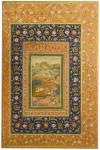   |
* SHIRIN MOURNING FARHAD'S DEATH
PROPERTY FROM AN IMPORTANT EUROPEAN PRIVATE COLLECTION
School of Mir Kalan Khan, Lucknow, Court of Awadh, Northern India, third quarter 18th century
Opaque pigments heightened with gold on paper, the vertical composition set in a realistically depicted landscape and capturing a crucial moment from the Khosrow o Shirin tragic romance by Nezami Ganjavi; in the centre Farhad, the Bisotun mountain stone carver, lying on the floor, his head bleeding and his mace near him; Shirin, the Armenian princess, kneeling next to him and mourning his death, a handkerchief in her hand, her attendants behind her in shock; in the foreground a guilty Khosrow with his horse, bringing his hand to his mouth expressing bewilderment in the typical Persian way, and wild animals such as sparrows, hares and ducks, all paused to pay respect to the scene; the background with hilly green landscape inhabited by peacocks, rams and villagers, Western-inspired building and castles on the right hand-side, birds flying up high in the sky; the whole composition framed within concentric bands of dense vegetal tendrils and floral scrollwork, the largest band with golden and polychrome-painted scrolling floral tendrils with stylised lotus flowers and rosettes, the final border with cusped cartouches possibly a later addition; an undeciphered seal in the back, mounted on a white cardboard, unsigned, 11.5cm x 6.8cm the illustration, 37cm x 24cm the folio.
Remembered as one of the most renowned painters of 18th-century India, Mir Kalan Khan started his early career at the court of Muhammad Shah in Delhi in the 1730s. Following the invasion and sack of Delhi by Nadir Shah (1739), many artists were compelled to leave the court and find new patrons. Mir Kalan Khan settled at the Awadh court and became its leading court painter, active both in Faizabad and Lucknow, producing an incredible body of eclectic and innovative works (Leach, Linda York, "Mir Kalan Khan and Provincial Mughal Painting of the Later Eighteenth Century" in Paintings from India, The Nasser D. Khalili Collection of Islamic Art, edited by Julian Raby, vol. 8. London, 1998, pp. 168-169).
His style and school are characterised by a unique and well-mastered assimilation of European, Mughal and Deccani elements, usually involving a naturalistic rendering of the landscape with a clear awareness of space and volume; a distinctive handling of foliage and light effects; Italianate and Flemish-inspired scenes and buildings influenced by European prints; bucolic settings typical of Deccani paintings; a mannerist use of colours; northern Indian and Mughal-inspired physiognomies and costumes; and last but not least, a sharp eye and interest for human feelings and reactions to the point of creating whimsical theatrical scenes (Malini Roy, 'Origins of the Late Mughal Painting Tradition in Awadh' in India's Fabled City: The Art of Courtly Lucknow, ed. S. Markel and T. Bindu Gude, Los Angeles, 2010, pp. 165 - 170). All the above-mentioned features are elegantly showcased in this beautiful composition, leading to suggest this lot was painted either by his direct pupils or by one of his followers.
A strikingly similar composition can be seen in a painting attributed to Mir Kalan Khan, successfully sold at Pundole's Mumbai, 9 April 2015, lot 119. The similarity lies not only in the style of the landscape and the division of the painting in foreground, centre and background, but also in the choice of the subject, taken this time from Leyla o Majnun, another famous tragic romance by Nezami Ganjavi.
£2,000-£3,000
|
|

|
* TWO ROYAL PORTRAITS
PROPERTY FROM AN IMPORTANT EUROPEAN PRIVATE COLLECTION
Mughal India, 19th century
Comprising two tinted drawings, opaque pigments, pencil and black ink heightened with gold on paper, the two vertical profile portraits depicting on the right a standing ruler, holding his embroidered sash, wearing a fur overcoat and a finely folded turban ornate with a jiga (turban ornament) holding a black heron feather with 5 pearls at the top; on the left a standing courtly lady, clad with a diaphanous shawl and skirt, embellished with an embroidered sash and an elegant turban with its ornament mirroring her counterpart, holding a wine cup and a bottle in her hands, possibly a 19th-century study from 17th-century Shah Jahan and Mumtaz Mahal's portraits, framed within lush gilt and polychrome floral borders, mounted on white cardboard, each 17.5cm x 8cm excluding mount.
£1,200-£1,800
|
|

|
A CITY VIEW OF MUZDALIFAH NEAR MECCA
Possibly Delhi school, North India, late 19th century
Opaque pigments and black ink on paper, the horizontal composition depicting a city view of Muzdalifah, lying between Mina and Arafat, and its open-roofed mosque known as Al-Mash'ar al-Haram, a tall minaret rising in the middle of the composition in line with the mountain top, a few houses in the surroundings, in the foreground villagers walking to the centre of the city, in the background a tall horizon, the composition set in concentric polychrome floral borders against cobalt blue ground and in the centre against light pink ground, on the lower pink border an Arabic inscription in black ink with a prayer relating to the Hajj, pilgrimage and mentioning the city of Muzdalifah, its location and the special prayers and rituals practised there during Hajj; mounted, framed and glazed, 41cm x 35.8cm including mount.
£600-£800
|
|

|
A TINTED SKETCH OF TWO CHILDREN WITH THEIR PARENTS
Possibly Mewar, Northern India, last quarter 19th century
Pencil, opaque pigments and black ink on paper, the vertical composition taking place on a terrace, the two parents in discussion, the two children attempting to catch their attention, behind them a maiden looking dreamily at the horizon, a rudimentary attempt to depict houses and landscape in the background, mounted on red cardboard, 29.4cm x 24cm including mount.
£300-£500
|
|

|
A VISITOR KNEELING IN FRONT OF A SEATED RULER
Punjab, Northern India, late 19th century
Opaque pigments heightened with gold on paper, the vertical composition with a kneeling visitor in the presence of an elderly ruler seated on a golden and bejewelled seat, behind him a standing attendant with a fly-whisk, near the visitor a standing official pointing at him, lavishly decorated architecture and lush landscape in the background, within black rules and bright red borders; mounted on cream white cardboard, 28cm x 22.3cm including mount.
£400-£600
|
|
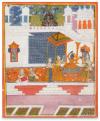 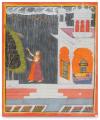 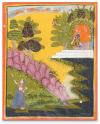 |
THREE MEWAR SCHOOL PAINTINGS
Mewar, Rajasthan, North India, 18th century
Musical modes variously expressed in opaque pigments on paper, depicting Krishna enthroned on a carpeted terrace at his toilette, a Gopi holding up a mirror for him as others wrap his turban and bring him fragrant ointments to the accompanying musicians, framed and glazed, 23.5cm x 19.5cm, 38cm x 28.5cm including frame; young ladies feeding a peacock on a stormy night, celebrating the Barsat, framed and glazed, 23cm x 19cm, 38cm x 28.5cm including frame; and Krishna seated in a verdant cave by the water in a landscape, vegetation between him and his female companion, framed and glazed, 23.5cm x 19cm, 38cm x 28cm including frame.
£800-£1,000
|
|

|
A BOAT SCENE
Pahari school, North India, late 19th century
Opaque pigments on paper, the all-female crew and passengers in an orange boat with a horse figurehead, rowing down a river, the elegant noblewoman and her attendants sheltered beneath the canopy of the boat, framed and glazed, 20.3cm x 14.2cm, 50.5cm x 36.5cm including frame.
£400-£600
|
|

|
A MUSICAL PERFORMANCE
Possibly Bikaner, Rajasthan, North Western India, mid to late 18th century
Opaque pigments heightened with gold on paper, the horizontal composition depicting a palace scene, on the interior maidens clean vessels used to cook and serve food to the royal family on the upper floor, on the exterior a musical performance taking place by the terrace with artists playing the sitar and tabla and dancers near them, the royal family in the front enjoying the show and surrounded by their courtiers, Rajput warriors holding their tulwars and shields by the entrance of the palace, court ladies on the upper floor chajjas looking at the horizon, set in later recoloured bright red borders, on the upper edge two lines of black ink Devanagari washed with red paint, ochre borders on the final edge, glued onto cardboard, 45.4cm x 30.6cm.
£800-£1,200
|
|

|
A RAJPUT PRINCE SEEKING ADVICE FROM A SADHU
Kangra, Pahari Hills, North India, mid to late 19th century
Opaque pigments heightened with gold on paper, the horizontal composition depicting a Rajput prince holding his hands tight in sign of greeting to an ascetic seated on gazelle's skin near his humble hut, next to him a water pot and holy scriptures, a white-clad devotee lying between them and bowing down in respect to the sadhu, the prince clad in pink and showcasing all his armorial equipment such as bow, quiver with arrows, tulwar, and black shield (dhal) on his back, the composition framed within white rosettes border on dark blue ground, set in bright red borders with polylobed cartouches filled with two to three lines of black Devanagari script against white ground, the verso with more Devanagari inscriptions, 37cm x 30.8cm.
£1,000-£1,500
|
|

|
A CEREMONY IN THE GARDEN
Kangra, Pahari Hills, Northern India, 19th century
Opaque pigments heightened with gold on paper, the horizontal composition depicting a crowned Krishna under a red canopy, next to him a group of seven maidens, one kneeling down, possibly Radha, with her face covered by a red scarf in a coy attitude, the other maidens behind her smiling and dressed in similar colours, in front of the procession a priest officiating the ceremony and reading passages from a holy book, two male sadhus with pots, and behind them two female musicians, the scene set in a garden inside a fortified palace, the architecture in tune with Northern Indian style, mounted, framed and glazed, 32cm x 24cm excluding the frame.
£500-£700
|
|

|
A NAYIKA BECKONING ANIMALS IN THE FOREST
Pahari school, North India, 19th century
Opaque pigments and gold on paper, the central female heroine resting against a lush green tree and holding one of her pearl necklaces to a curious fawn, a gazelle staring, birds chirping in the sky and some resting on the branches of the tree, the composition framed within bright red and blue borders marked with white lines, an inscription in Arabic letters at the top Jiji vanta rakhni, mounted, framed and glazed, 48.5cm x 35cm.
£1,800-£2,000
|
|

|
A LADY ON A TERRACE
Kangra school, Pahari Hills, North India, mid to late 18th century
Opaque watercolour on paper, the pensive elegant maiden dressed in white, gold and green, and holding a leaf, standing on a terrace contemplating ducks in an ornamental pond, before a balconied edifice within a walled garden, the dark blue border with white and gold decoration and terracotta outer border, raw silk off-white mount, framed and glazed, 23.5cm x 29cm, 46cm x 50cm including frame.
Label on reverse: 33 Cork Street, W1 1HB
£2,000-£3,000
|
|

|
LORD KRISHNA BEHEADING TWO DIVS
Kangra, Pahari Hills, North India, first half 19th century
Opaque pigments heightened with gold and black ink on paper, the horizontal composition depicting Lord Krishna with his gilt club and chakram (quoit) effortlessly slaying two demons, the one already beheaded with red skin, eagle-shaped claws, lion's tail, with horns on his head and fangs in his mouth, the latter with fish scales and eagle-shaped claws, both holding tulwars, the composition framed within white rosettes border on dark blue ground, set in bright red borders with polylobed cartouches filled with two to three lines of black Devanagari script against white ground, the verso with more Devanagari inscriptions, one blank loose folio attached to the painting, 37.2cm x 30.5cm.
£1,400-£1,600
|
|

|
A NOBLEMAN SMOKING A HUQQA
Guler school, Pahari Hills, Northern India, second half 18th century
Opaque pigments heightened with gold on paper, the vertical composition with a nobleman kneeling on an ochre ground with red vegetal tendrils, possibly a summer carpet, resting against a red cushion with gold decoration, smoking a huqqa on a terrace with a pensive look, a katar and a spittoon on the floor near him, his simple white outfit embellished by a gold band on the turban and a pink shawl, the composition within white lines and dark blue border, takri, nagari and nasta'liq inscriptions on reverse mentioning the name of Miyan Kuber Chand Katoch; mounted on a white cardboard frame, 25.7cm x 16.3cm excluding the white cardboard mount.
Provenance: Bonhams Bond Street, 5 April 2011, lot 287.
£1,500-£1,700
|
|

|
A NOBLEMAN SMOKING A HUQQA
Guler school, Pahari Hills, Northern India, late 18th century
Opaque pigments heightened with gold on paper, the vertical composition viewed through a polylobed Mughal arch and depicting a nobleman, possibly a young Raja Prakash Chand of Guler kneeling on a summer carpet by the terrace and smoking his huqqa, resting against a typical oval pillow, his sword and shield beside him, on his right a blossoming prunus tree, behind him an attendant holding a flywhisk, set within dark blue borders embellished with white floral tendrils, mounted, framed and glazed, 41cm x 28cm including the frame.
Provenance: Christie's South Kensington, 9 October 2009, lot 501.
£1,800-£2,000
|
|

|
LORD GANESHA WITH CONSORTS RIDDHI AND SIDDHI
Kangra, Pahari Hills, North India, late 19th century
Opaque pigments heightened with gold on paper, the horizontal, oval composition depicting Lord Ganesha seated cross-legged on a golden canopy throne, with a golden halo and clad in pearl strings and jewellery, on the left his consort Riddhi (prosperity) offering him his favourite treat, laddus, and water in a bejewelled golden water pot, Siddhi (spiritual power) on the right fanning him with a fly-whisk and holding a handkerchief, his faithful vahana (vehicle) Mus lying on the left of the throne; framed within floral borders on dark blue ground, gilt arabesques on the corner on white ground, on red speckled, pink-washed paper, mounted on white cardboard, 47.2cm x 32cm including mount.
For a similar example, please see Bonhams New York, 14 September 2015, lot 114.
£800-£1,200
|
|

|
A FINE SKETCH FROM A RAMAYANA SERIES
Possibly Kulu or Bahu, Punjab Hills, India, 18th century
Red ink on burnished paper, the horizontal composition portraying Rama and his brother Lakshmana with King Sugriva's monkey army, all characters depicted in profiles, holding their arms, Rama and Lakshmana with their bows; the verso with 2ll. of red ink Devanagari script, mounted on black cardboard, 32.8cm x 20.4cm including mount.
The style of the composition and the fineness of the characters' faces are reminiscent of Shangri Ramayana illustrations. The theme is also a particularly dear one to Kulu and Bahu paintings' production.
£800-£1,200
|
|

|
AN EQUESTRIAN PORTRAIT OF A RULER
Mewar, Rajasthan, North India, early 20th century
Opaque pigments heightened with gold on paper, the vertical composition with a Rajput ruler on a horse holding his lance, the ruler portrayed in profile and with a golden halo, his saddle shaped as a swan, tall horizon over hilly landscape in the background, framed within dark red borders with silver shrubs and floral bloom, the verso with black and red ink and pencil Devanagari inscriptions; mounted on white cardboard, 43.5cm x 36.2cm including mount.
£200-£300
|
|

|
THE GOD OF WEALTH KUBERA SEATED ON A CANOPY
Mewar, Rajasthan, North India, 19th century
Opaque pigments heightened with gold on paper, the vertical composition with the God of Wealth, Kubera, seated cross-legged on a bird-shaped canopy caparisoned with golden pendants with pearls, the god holding an encrusted golden club in his hand, his headdress fully bejewelled, the composition on a dark blue ground, the upper edge with 2ll. of black and red ink Devanagari inscriptions against an ochre ground, set within yellow and bright red borders, mounted, glazed and framed, 42cm x 35.5cm including mount.
Provenance: Purchased at Kasmin Gallery, London, in the late 1960s and in UK private collection since.
£500-£700
|
|
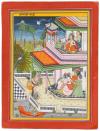 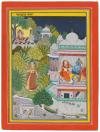 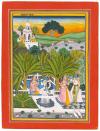 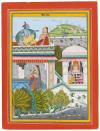 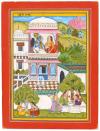 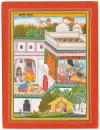 |
A COMPLETE SET OF BARAMASA ILLUSTRATIONS
Bundi, North West India, first half 20th century
Opaque pigments heightened with gold and black ink on paper, each illustration in vertical format depicting a month of the calendar year, identified by its name on the upper left corner in black Devanagari ink on ochre ground, Lord Krishna present in each illustration from Holi to Diwali, from day to night, always in the company of his consort, the characters of each illustration engaged in various courtly pastimes, rites and prayers, set within ochre, light grey and bright red borders, the verso reinforced with extra paper with notes and comments, 35.4cm x 26.6cm.
£1,400-£1,600
|
|

|
A SHAIVA SADHU AND FEMALE COMPANION
India, 19th century
Opaque pigments on paper, the figures in a landscape, panther pelt, bow, and sword attesting to the identity of the sadhu, the attendant offering him a conch shell and the brass bell, mounted, framed and glazed, 24.5cm x 16.5cm, 37cm x 29cm including frame.
£200-£300
|
|

|
A PORTRAIT OF KING MADHO SINGH II (r. 1880 - 1922)
Jaipur, Rajasthan, North Western India, first half 20th century
Opaque pigments heightened with gold on paper, the vertical portrait depicting a young Madho Singh II seated on a chair in a colourful palatial interior, crossing his legs and looking straight at the beholder, portrayed in his princely attire, holding a long tulwar; mounted on stained cardboard, 28cm x 17cm including mount.
£300-£500
|
|

|
FOUR INDIAN PAINTINGS
India, late 19th - early 20th century
All in opaque pigments on paper, comprising an elegant lady wrapped in a do-shala shawl and bedecked in pearls, holding a cup, standing in profile against a verdigris background, within a gilt madder mount laid on gilt pink paper, framed and glazed, 26.5cm x 17cm, 38cm x 28.5cm; the apparition of an angel to a kneeling sadhu holding a black rosary by a fire, framed and glazed, 11.5cm x 18.2cm, 22cm x 28.5cm including frame; a scene from the Bhagavata Purana, Krishna playing hide-and-seek in a rocky landscape with magical visages appearing in the rocks, 13cm x 17.5cm, 22cm x 28.5cm including frame; and a Mewari painting of Nandi ridden by a sadhu, with peacocks, birds, and devotees, the one in the foreground throwing a garland beneath the Nandi's hooves, framed and glazed, 7cm x 12cm, 18cm x 26cm including frame.
£500-£700
|
|

